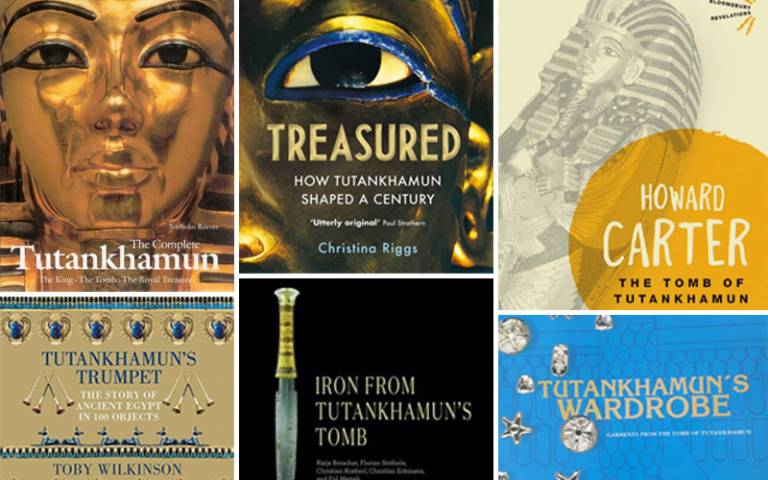One hundred years of Tutankhamun or an Egyptian pharaoh in six books
1 December 2022
Katie Meheux, UCL Institute of Archaeology Librarian, provides book suggestions on the Egyptian pharaoh Tutankhamun (c. 1341-1323 BC), as this month it will be one hundred years since the discovery of the pharaoh's tomb.

Tutankhamun's tomb was discovered in the Valley of the Kings by the Earl of Carnarvon, Howard Carter, and their excavation team in November 1922. The tomb produced 5398 items, including a solid gold coffin, face mask, thrones, bows, trumpets, furniture, food, wine, and linen underwear. Its discovery astonished the world with its glamour, riches, and drama. ‘Tutmania’ gripped western popular culture, influencing literature, architecture, fashion, art, even biscuit tins. Deaths among the excavation team fuelled the notorious ‘Curse of King Tut’.
A century later, our fascination with Tutankhamun remains as strong as ever. An exciting range of resources are available to celebrate the centenary, including the exhibition Tutankhamun the Boy: Growing Up in Ancient Egypt by our Library, Culture, Collections and Open Science partner, the Petrie Museum. As our contribution, the Institute of Archaeology Library, home of the Edwards Egyptology Library, looks at Tutankhamun through six books, held in the Edwards Library or online through the UCL Library catalogue.
Six books on Tutankhamun
The tomb of Tutankhamun : discovered by the late Earl of Carnarvon and Howard Carter by Howard Carter and A. C. Mace. London: Bloomsbury, [2014].
The clearance of Tutankhamun’s tomb and the transportation of the objects interred there took Carter almost a decade. This book, originally published in three volumes between 1923 and 1933, provides a first-hand, autobiographical account of the work. It provides a vivid picture of the complexity and sheer enormity of the task the excavators faced in clearing the tomb, documenting the finds, and ensuring their preservation for the future.
The Complete Tutankhamun: the king, the tomb, the royal treasure by Nicholas Reeves. London: Thames & Hudson, 1990.
A thorough introduction in a clear, approachable style for anyone new to the study of Tutankhamun and wanting more – more details, more history, more context. An approachable, engaging overview with colour pictures and ‘bite size’ narratives about everything ‘Tut’ - the Valley of the Kings, the tomb layout, the famous gold coffins, small objects from the tomb, the discovery, and the excavation team. Guaranteed to send you away feeling like an expert.
Tutankhamun’s trumpet : the story of ancient Egypt in 100 objects by Toby Wilkinson. London: Picador, 2022.
Whilst most books on Tutankhamun focus on the pharaoh and the discovery of the tomb, this book takes a refreshingly different approach, using the objects buried with him as source material for a wide-ranging, detailed portrait of ancient Egypt – its geography, history, culture, and legacy. Want to learn more about Tutankhamun’s trumpet and how it was played on BBC radio three and a half thousand years later? This is the book for you!
Tutankhamun’s wardrobe : garments from the tomb of Tutankhamun by G. M. Vogelsang-Eastwood. Rotterdam : Barjesteh van Waalwijk van Doorn & Co.
Regal socks and sandals? The exotic ‘treasures’ from Tutankhamun’s tomb have been widely celebrated, but the garments, organic objects that rarely survive in archaeological contexts, are just as exciting. There are 145 loincloths from the tomb, sandals, socks, tunics, shawls, aprons, kilts, and cloaks. These textiles tell us about Egyptian cloth production and decoration, not to mention royal fashion. One spectacular tunic gives us an insight into Bronze Age ‘bling’ - decorated with pale blue faience beads and gold sequins.
Iron from Tutankhamun’s Tomb by Katja Broschat et al. Cairo : The American University in Cairo Press, 2022.
Tutankhamun and extra-terrestrials? But not as you might think! Scientific analysis of the iron objects from the tomb has revealed that they were made from meteoritic iron. While scientists are not able to identify the source meteorite, they do believe that the iron daggers, rare in Bronze Age Egypt, may have been luxury goods traded or given as diplomatic gifts from the ancient Near East, perhaps the kingdom of the Hittites in ancient Anatolia. More mysteries from the tomb of Tutankhamun.
Treasured : how Tutankhamun shaped a century by Christina Riggs. London: Atlantic Books, 2021.
Like Howard Carter’s account of the discovery of the tomb, this is an autobiographic study of the author’s encounters with Tutankhamun, told first-hand. Christina Riggs weaves her personal narrative into a compelling historical analysis that examines the impact of the discovery on the twentieth century. From pop culture and politics to tourism and heritage, she examines how our many, diverse, and constantly changing encounters with Tutankhamun tell us as much about our world as his own.
 Close
Close

